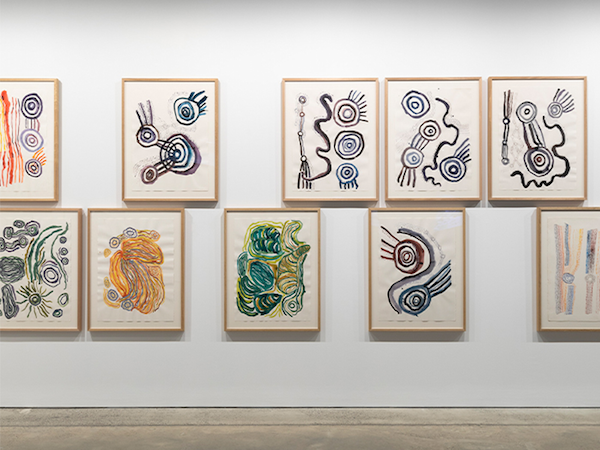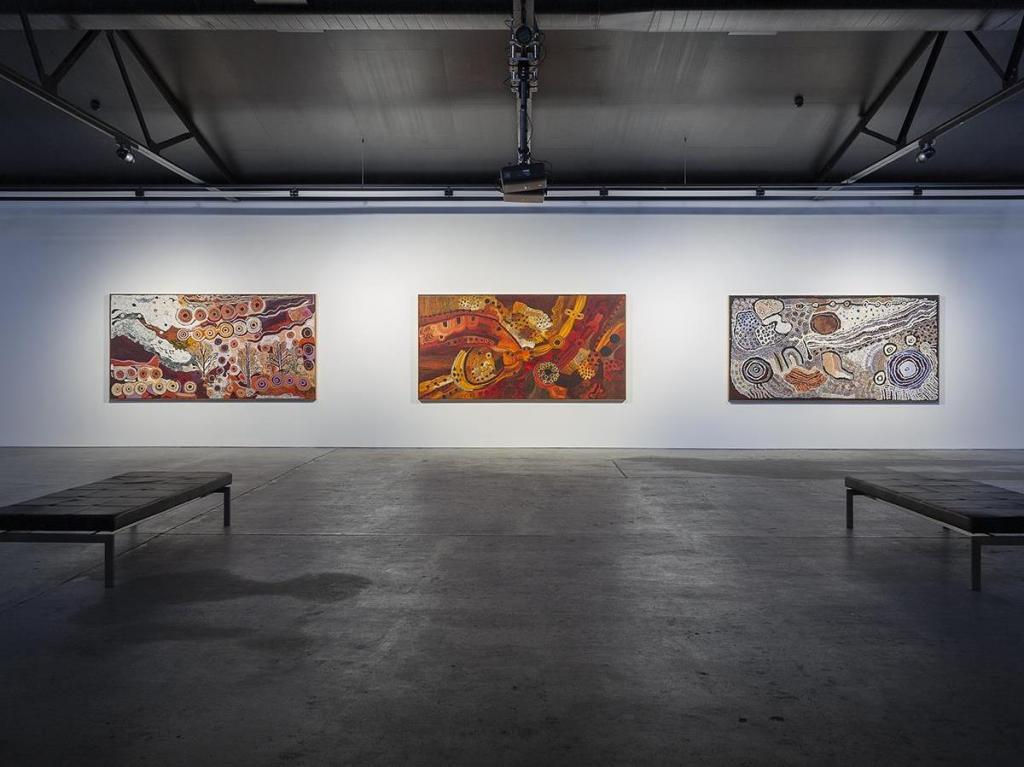Image featuring works by Senior Mens Wati Collabroative, Kanpi Collective and Watarru Collabroative, Artbank Melbourne. Photo Christian Capurro
In a decisive move, Aṉangu law man Keith Stevens made the call to take a group of senior artists, together with younger artists, out of the art centre and on to Country to identified sites to paint their stories.
It was his vision to not only paint ‘big stories’ at big scale where they had been traditionally handed down, but to document the journey with video.
Two years later, we are witness to that incredible cultural journey through the exhibition, Tjungu Palyangku Tjukurpa titutjara kunpu ngaranytja-ku (As we come together we stand strong for our story), presented in tandem across Artbank’s Sydney and Melbourne venues.
It retells Tjukurpa (sacred stories) through very different mediums: from a suite of 32 delicate ink drawings – studies for the painting on country project – to the resulting collaborative paintings, each an expansive 3-meters wide. There is also a new foray into six performance videos – a first for this community.
The works were created by 12 artists from the Aboriginal-owned corporation, Tjungu Palya Art Centre, which sits at Nyapari, approximately 20 kilometres south of the Northern Territory border and around 450 kms south west of Alice Springs in
South Australia.
Artbank’s Senior Curator Oliver Watts explained that the idea to broaden this exhibition came out of the purchase of the ink drawings for the Artbank Collection in 2017.
‘It was because of the strength of the inks, that we really wanted to double down and consider those Tjukurpa, those stories in more detail,’ Watts said.
Watts travelled with Artbank’s former Director Tony Stephens to the desert to visit the sites and to spend the time to listen to these stories. ‘We wanted to properly engage with the community and the stories they wanted to tell. It is an important exhibition for Artbank,’ he continued.
Artbank and Tjungu Palya extended their partnership with the commission of three major collaborative paintings by the Watarru Collaborative, Kanpi Collective and the senior men’s Wati Collaborative.
‘These works are both physically and conceptually immense. It is really important for us to highlight that this is contemporary practice,’ said Watts.
‘While the stories go back to drawing Tjukurpa in the sand, these are new interpretations, they are acrylics on Belgium canvas, French inks on German paper, and they use drone video – there is nothing about the practice of these artists that that isn’t contemporary, and it is this trans-historical hybrid use of mediums that is so exciting,’ he added.

Image featuring works by Beryl Jimmy, Watarru Collaborative, Ruth Fatt and Bernard Tjalkuri. Photography by Silversalt.
More than ethical collecting, it’s community-led curating
This is not the first time that Artbank has curated, and toured, an exhibition of commissioned artworks by Aboriginal artists. In 2012 its show BALGO: Contemporary Australian Art from the Balgo Hills, travelled across the Pacific, Asia and Latin America.
Next year Artbank celebrates its 40th anniversary, and one of the stories of that legacy has been the way it has engaged with communities and artists over a long period, rather than being reactive to the spikes and cycles of the art market.
‘We try to ethically collect, and there is minimal curation to this show; it is how community wanted it presented,’ Watts told Artshub.
Part of that consultative process was to bring in Clothilde Bullen, Curator, Aboriginal and Torres Strait Islander Collections and Exhibitions at the Museum of Contemporary Art Australia.
Bullen said: ‘There is an intimate connection between the passing on and taking up of knowledge connected to country and the artistic practices and outcomes that derive from that. The correct and indeed most useful way to enable cross-generational transmission of cultural knowledge is to bring people out to Country, to speak on country and contextualise learnings.’
That spirit of sharing is captured in the words of artist Maringka Baker: ‘In our paintings you can see all the different parts of these landscapes as they were shown to the younger sister. When I am painting with my daughter, I am showing her these places.’
Maringka Baker with family Kani Tunkin Baker and Teresa Baker painted the Kanpi Collective painting Minyma Kutjarra Tjukurpa, 2018.
Bullen added of the commissioned paintings: ‘Each work presents “big” stories, stories that connect vast tracts of land with all-encompassing narratives embedded within. Each painting mediates between the visible and the concealed.’
Senior artist Keith Stevens suggests these ‘big stories’ are ‘open stories’ that can be told to neighbouring nations.
‘The stories are related to sites where other people have been welcomed and received for centuries. Only relatively recently Aṉangu decided that these stories could also, by extension of the concept of openness and neighbourliness, be shared across cultures,’ Watts said.
It was Stevens who was instrumental in pushing forward into video. ‘He kept being told that he is a great painter, but in the APY Lands he is deeply respected for the singing and dancing of the songlines, and it was his desire to use video to get that Tjukurpa down,’ Watts told ArtsHub.
The exhibition shows the vibrancy and contemporary nature of their stories through inma (performing sacred ritual).
‘While the paintings have great wall power, walking the land and knowing the land through singing is how these stories are passed down, and curatorially we wanted to share that journey through video,’ added Watts.
It was a perfect match for Teresa Baker, who has a great passion for, and knowledge of contemporary cinema and television, which she fuses with traditional story telling in her debut work.
She says of her work: ‘I keep this Tjukurpa in my spirit. My grandfather taught me to paint this story and now I am teaching my grandchildren so they are strong inside too, for when it is their turn to take over the land.’
Bullen added: ‘There is a degree of agency in the production of film by Indigenous Australians that is able to contest colonised representations of Aboriginal people by western filmmakers…A number of films have been produced for the current show that offer a multiplicity of pathways to appreciate Aṉangu understandings of the holistic nature of storytelling.’

Installation view Artbank Melbourne (2019), featuring works by Senior Mens Wati Collabroative, Kanpi Collective and Watarru Collabroative accompanied by video projections; Photo Christian Capurro
For the Melbourne exhibition the videos will be shown alongside the three collaborative paintings, while in Sydney, it is the suite of inks they are shown with – the book ends of this project that is a celebration of innovation and creative journeying led by Tjungu Palya.
All of the artworks in the exhibition have been acquired for the Artbank Collection, and will be available to lease, and there are plans to tour the videos.
Artbank’s leasing scheme allows individuals and organisations to rent Australian artworks to be displayed in their chosen space. The leasing fees contribute towards supporting emerging Australian artists.
Tjungu Palyangku Tjukurpa titutjara kunpu ngaranytja-ku | As we come together we stand strong for our story
Artbank Sydney, 18 July to 8 November 2019
Artbank Melbourne, 25 July to 8 November 2019
Artsists include: Teresa Baker, Maringka Baker, Kani Tunkin Baker, Ruth Fatt, Kunmanara (Wipana) Jimmy, Beryl Jimmy, Imitjala Pollard, Keith Stevens, Bernard Tjalkuri and Ginger Wikilyiri.
For more information visit: www.artbank.gov.au/exhibitions





